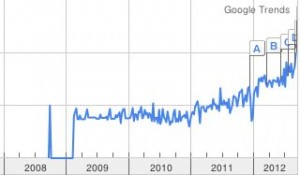 Are we there yet?
Are we there yet?
Those four words likely conjure up the thought of a seemingly endless road trip of days past. Luckily for you, I’m not going to be talking about road travels in today’s post. No. I have a very different thought in mind, and that is the notion of ongoing optimization.
When is my Content Optimized?
When I speak with friends and family about our work here at TopRank, I’m often asked the question ‘when is a site optimized?’ It’s a fair question, especially considering what typically precedes it is my soap box speech on the importance of optimizing content with the customer’s wants and needs in mind. So what do I say? My answer is always the same: it’s an ongoing process. Now, that’s not to say that we aren’t constantly moving the needle towards a more optimized site, but I view ‘optimized’ as a state of absolute perfection. A moment where every page, text, image & call-to-action (CTA) perfectly align with the wants and needs of an audience. Here’s the part that can either drive you crazy or inspire you as a marketer, there are too many variables at play to ever reach such a state of perfection. I’m talking about variables like:
- fluctuations in keyword demand
- changes in user preferences
- search and social updates
So for those of you actively involved in optimization activities who are wondering ‘are we there yet?’, I can tell you the answer is ‘no’ but you’re in for a fun ride.
The Importance of Ongoing Content Optimization
-Fluctuations in Keyword Demand
Let’s consider the growth of content marketing as a keyword. In 2008, ‘content marketing’ was little more than a whisper. Few businesses or marketers were using the phrase online and, as the Google Trends screenshot to the right suggests, even less were searching for it.
Cut to today, where the exact phrase ‘content marketing’ can be found on over 4 million web pages, including over 2 million blog posts. The growth in popularity for content marketing can teach us a valuable lesson on the importance of constantly researching and updating your keyword glossary. A term that was popular 12 months ago may no longer resonate with searchers. Alternatively, if you’re not constantly researching new keywords you may miss the next emerging phrase in your industry.
Establishing and committing to a schedule for researching keywords is a critical element to ongoing optimization. The frequency in which you conduct your research may vary depending on the popularity and competitiveness of your industry. You may find that this research needs to be conducted on a monthly, semi-monthly or semi-annual basis. When you do research your keywords, begin by entering your existing glossary of keywords into tools like Google’s Keyword Tool to identify if there have been any significant changes in the search demand for your terms. Next, use tools like Ubersuggest to find additional terms that may deserve a place in your ongoing optimization strategy.
-Changes in User Preference
What a user may expect by entering a search term may change over time. Let’s revisit the growth of content marketing as an example of how content must evolve in conjunction with searcher’s expectations. In 2008, as the idea of content marketing (as least as it known today) was in its infancy, it would be rather assumptive for businesses to jump right into advanced content marketing tips and strategies in their content without laying out some foundational information on what constitutes content marketing. At that time in may have been more effective to supply heavier copy to help nurture visitors understanding of the term. In 2012, very few visitors who enter the query ‘content marketing’ likely need a hefty overview of the practice. Rather, users are now likely looking for stellar examples, new tips or even a list of recognized agencies that can help (cough TopRank).
One way to get a glimpse now into what content users are preferring related to a particular topic is to take a look at the search results for the first two pages of Google, Bing and Yahoo!. Are you finding that videos are consistently appearing at the top of the results? Do infographics and visual heavy pages appear? This may suggest images and video are resonating with users.
Mix in your own data from analytics as well in your research. What pages receive the most visits? Which are most successful in generating relevant keyword visits? Most importantly, which pages are effective at compelling visitors to act (i.e. downloads, contact requests, demos, etc.)? These pages are your top performers, so identify their common traits and use that information to flavor new content. Remember, your top performers can and will change. So leverage your analytics on an ongoing basis.
-Search & Social Updates
One thing is certain, there will always be a new social network. And with each update comes a new opportunities. When Google rolled out their latest foray into social, Google+, many initially scoffed at what appeared to be a network that offered similar functions and features offered by Facebook. While the actual level of engagement Google+ offers users and marketers alike can still be debated today, no one would argue that it has significantly influenced how Google+ users discover and interact with content within Google search.
With each search or social update comes an opportunity to reevaluate your content. In the case of Google+, there may be an opportunity to create a compelling user experience within the social network. Through research, you can uncover if your target audience is using Google+. Dig deeper to determine which content they +1. This information can help you lay the groundwork for a solid social editorial plan. By connecting with your audience in Google+, you can not only increase your touch points but potentially influence those in their circles as well.
While this post may have only scratched the surface of the importance of ongoing optimization, I hope it’s clear that while the question of ‘are we there yet?’ may inevitably surface in your road trips, it doesn’t have a place in your marketing mindset.
Gradient Circle Image provided via Shutterstock.


